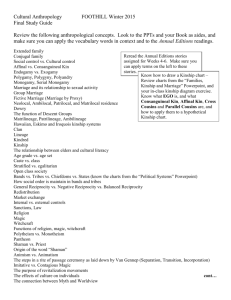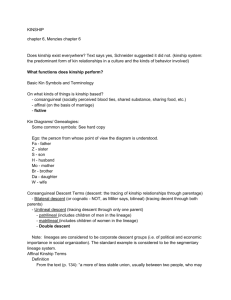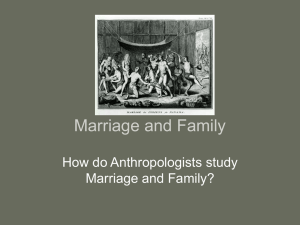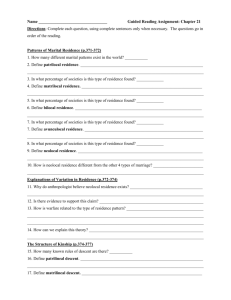Midterm Exam Review
advertisement
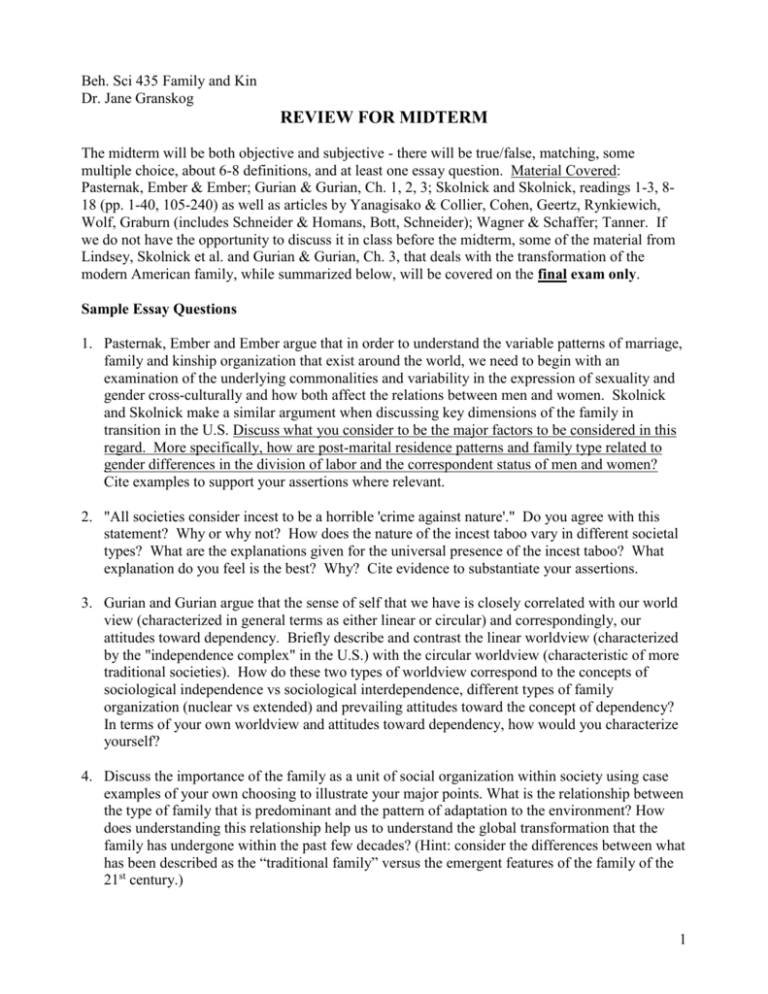
Beh. Sci 435 Family and Kin Dr. Jane Granskog REVIEW FOR MIDTERM The midterm will be both objective and subjective - there will be true/false, matching, some multiple choice, about 6-8 definitions, and at least one essay question. Material Covered: Pasternak, Ember & Ember; Gurian & Gurian, Ch. 1, 2, 3; Skolnick and Skolnick, readings 1-3, 818 (pp. 1-40, 105-240) as well as articles by Yanagisako & Collier, Cohen, Geertz, Rynkiewich, Wolf, Graburn (includes Schneider & Homans, Bott, Schneider); Wagner & Schaffer; Tanner. If we do not have the opportunity to discuss it in class before the midterm, some of the material from Lindsey, Skolnick et al. and Gurian & Gurian, Ch. 3, that deals with the transformation of the modern American family, while summarized below, will be covered on the final exam only. Sample Essay Questions 1. Pasternak, Ember and Ember argue that in order to understand the variable patterns of marriage, family and kinship organization that exist around the world, we need to begin with an examination of the underlying commonalities and variability in the expression of sexuality and gender cross-culturally and how both affect the relations between men and women. Skolnick and Skolnick make a similar argument when discussing key dimensions of the family in transition in the U.S. Discuss what you consider to be the major factors to be considered in this regard. More specifically, how are post-marital residence patterns and family type related to gender differences in the division of labor and the correspondent status of men and women? Cite examples to support your assertions where relevant. 2. "All societies consider incest to be a horrible 'crime against nature'." Do you agree with this statement? Why or why not? How does the nature of the incest taboo vary in different societal types? What are the explanations given for the universal presence of the incest taboo? What explanation do you feel is the best? Why? Cite evidence to substantiate your assertions. 3. Gurian and Gurian argue that the sense of self that we have is closely correlated with our world view (characterized in general terms as either linear or circular) and correspondingly, our attitudes toward dependency. Briefly describe and contrast the linear worldview (characterized by the "independence complex" in the U.S.) with the circular worldview (characteristic of more traditional societies). How do these two types of worldview correspond to the concepts of sociological independence vs sociological interdependence, different types of family organization (nuclear vs extended) and prevailing attitudes toward the concept of dependency? In terms of your own worldview and attitudes toward dependency, how would you characterize yourself? 4. Discuss the importance of the family as a unit of social organization within society using case examples of your own choosing to illustrate your major points. What is the relationship between the type of family that is predominant and the pattern of adaptation to the environment? How does understanding this relationship help us to understand the global transformation that the family has undergone within the past few decades? (Hint: consider the differences between what has been described as the “traditional family” versus the emergent features of the family of the 21st century.) 1 5. How does Lindsey's definition of the family differ from traditional definitions of the family? Illustrate your comments with examples of the different types of non-biological families that she discusses. What are the key criteria for defining a chosen family? Finally, can you define nonbiological familial relationships that you have developed -- if so, do they fit Lindsey's description? OUTLINE OF KEY TERMS AND CONCEPTS I. Introduction to the Study of Kinship, Marriage and the Family A. Historical development of studies in kinship and social organization - Be familiar with major features of approaches. 1. Unilineal evolutionists - Morgan, Bachoffen, etc.; contributions - defn. of terms, transformation of kin systems; problems w/ approaches - ethnocentric bias, notion of "progress", etc. 2. Structural functionalism - Radcliffe-Brown and Malinowski; emphasis on the structure of kin grps. functioning to promote solidarity of group., emphasis on continuity; problems bias, static (unable to account for change) 3. Changes in the approach to kinship - Firth (social organization vs social structure), Murdock (statistical approach), Levi Strauss (French Structuralism - marriage as alliance); emphasis on processual approaches (ethnosemantics, ethnoscience, general systems analysis) & more recently, the dialectical approach (Yanagisako & Collier - note three facets of approach) B. Impact of Sexuality and Gender on Family and Kin 1. Note biological and cultural impact of views toward sexuality re: restrictions and variable expression -- variant attitudes toward premarital sexual relations, homosexuality, & conditions under which sex is viewed as dangerous. 2. Impact of biology on gender - three areas of influence; note definitions of key terms - core gender identity, gender role, gender role identity. 3. Note 3 key factors in understanding sexual behavior - individual gender role identity, nature of relationship between sexes and the socio-cultural context. Also note three major components of the socio-cultural context - ecosystem, socio-economic system, ideology. 4. Note major differences in the gender socialization of females vs males and consequences for gendered division of labor. 5. Be familiar with major theories used to explain gendered division of labor and impact of differential contributions to subsistence; link between contribution to subsistence & status -female centered social structure linked to higher female status. C. Overview of Principles of Kinship and Descent (note specifics below also) 1. General types of groups - family, extension of the group through marriage and descent (consanguines vs affines); basic bonds within kin groups; difference between kinship and descent as cultural principles (from Keesing, p. 21) 2. Kinship groups and their characteristics a. unilineal - based on principle of inclusion - lineage, clan, moiety (2 groupings of clans in society), phratries; are bounded groups b. non-unilineal - bilateral/cognatic –unbounded networks except for personal kindred, stemkindred II. Basic Features of Marriage, Residence, and the Family 2 A. Overview of Marriage and Residence 1. Definition and functions of marriage .a. Definition. - sexual and economic union, 2+ people, legitimizes offspring and establishes reciprocal rights between husband, wife, and children b. Basic functions - exchange (brideprice/service, dowry), alliance, economic cooperation, responsibilities of parenthood - legitimacy etc. 2. Who to marry - rules of exogamy & endogamy, cousin marriage (cross vs parallel cousins) 3. How many to marry - definitions, characteristics of each form a. monogamy, serial monogamy b. polygamy - plural spouses: polyandry, fraternal polyandry (Toda - land scarcity); polygyny, sororal polygyny; Sinhalese (Sri Lanka) associated polyandry, polygynandry; secondary marriages c. note reasons cited for prevalence of polygyny and conditions under which polyandry may be found d. variations in marriage rules - levirate and sororate - illustrates contractual characteristics of marriage - alliance between groups 4. Note major points re: marital choice - arranged vs "romantic love"; variations in marital relations and divorce and remarriage; changing patterns in America (decline in dating, rise of college hookup, cohabitation rates, features of divorce culture); significance of the case of the Na in S. China (Geertz) B. Significance of Postmarital Residence 1. Note major types of residence and frequency of occurrence (advantages & disadvantages) neolocal, matrilocal (uxorilocal), patrilocal (virilocal), avunculocal, natalocal (remaining in family of orientation), bilocal (transitory form of residence) 2. Problems with defining residential forms - what constitutes patrilocal residence for example (emphasis on shared resource usage) 3. Note major points re: determinants of post-marital residence, functions and bases of given residence forms (importance of various environmental pressures, contributions to subsistence, and presence of warfare). Point: kinship systems and residence forms are more or less flexible - they will change when environmental and social pressures make it necessary C. 1. 2. 3. 4. 5. Characteristics of the Family and Household - Nature and functions of the family and its historical significance including global transformation taking place today Definition (universal functions, significant role relations, family vs. household) Forms of family and characteristics: independent/nuclear - variations, advantages and disadvantages; extended (vertical - thru descent; horizontal - thru marriage), advantages and disadvantages Questions re: universality of the family (Kibbutz, Nayar cases) Definition of context necessary to understand transformation of family and kin groups, specifically: socio-historical (norms); socio-economic (ecological factors - ecosystem, most significant factor); external relations with other groups. Re: change -- technological changes accepted before changes in social relations, values last to change usually. Note summary points regarding characteristics of the family and criteria for chosen kin (friends as family - see points re: Lindsey below) 3 III. The Incest Taboo A. Definition and Characteristics of the Incest Taboo 1. Definition - sexual relations with individuals defined as close kin 2. Is distinguished from proscriptions re: marriage - endogamy & exogamy; incest is always defined as intra-group 3. Relative presence of incest taboo and how it is defined (what relatives it includes) depends on: structure of the family and larger kin groups, role relations within the family, and most importantly, the nature of the larger socio-economic-political sphere (most extensive in foraging and tribal societies, least extensive - nuclear family - in post industrial society) B. Explanations for the incest taboo 1. No single universal explanation - variety of reasons; be familiar with Cohen's argument re: significance of external trade & alliances outside the group and the distinction between "core incest taboo" (relations between consanguinal related members, nuclear family) vs "extended incest taboo" (other kin outside core) and its consequences. Cohen's argument re: "core incest taboo" vs extended incest taboo: need for privacy w/in boundary maintenance groups (networks in which people establish socio-emotional. identity); sexual relations w/in boundary. maintenance group threaten psychological well being of individual & survival of group; requirements of socialization process for individual to form bond w/ caretakers & then separate from them 2. No universal horror of incest - emphasis on range of variation in attitudes 3. Incest is often avoided rather than prevented - part of our cultural 'baggage' C. Evaluation of incest in American society 1. Characteristics of those who commit incest - father-daughter incest most common; often considered as a form of child molestation 2. Prevalence - reported incidence much higher in recent years, actual incidence likely even higher; may be in part due to raised consciousness/awareness of the issue 3. Must be evaluated in the context of societal characteristics - patriarchal societies, families who are isolated from social context 4. Consequences for victims of incest IV. Basic Characteristics of Unilineal Descent Groups (U.D.G.'s) and Non-Unilineal Descent Groups A. General characteristics - U.D.G.s associated w/ sedentary and/or pastoral tribal societies (about 2/3 of all societies); difference between patrilineal and matrilineal systems, context where found, frequency of occurance, etc. Review major points in Pasternak, Ember & Ember, Ch. 12, (see also Fox on reserve, pp. 120-121) B. Definition and problems with matrilineal descent groups 1. Methods of formation - three feasible forms B1a. keep all members together - consanguinal matrilineal group - residential group (natalocal); Nayar, Black Carib b. keep females together, disperse males - matrilocal residence; Navajo and Hopi (tend to be brittle marriages, difficult under conditions of land scarcity) c. keep men together, disperse females - avunculocal residence with patrilocal marriage 4 2. General considerations re: M.D.G.s - relation to the outside world (economic and political re: role of genders); key role of women in subsistence activities; associated with horticultural societies C. Patrilineal descent groups (majority in tribal societies, formation - get rid of sisters, obtain wives; control over wives, including reproductive rights). Note variations in kinds of patrilineal descent groups that may be present D. Double descent - definition, different from complementary filiation and cognatic descent; conditions under which system prevails; Yako, Nigeria E. 1. a. b. Cognatic descent groups and bilateral networks Basic types of groups & characteristics ego focus (personal kindred) - unbounded, can't be corporate ancestor focus (e.g. stem kindred, sept, ramage) - are C.D.Gs - can be corporate, residential groups if restricted either pragmatically by choice or by residence (territorial residence); if unrestricted cannot be corporate 2. Conditions under which they occur - association w/ island populations V. Current Approaches in the Examination of Family and Kin A. Structural approach - continuation of earlier emphasis on preferred patterns - norms (ideal vs "real") 1. Emphasis on the structure of role relationships within the family & larger kin groups 2. Ideal is not the same as the real in part due to the differential internalization of norms by individuals & groups 3. Recent re-formulation of this kind of approach is in studies that focus on culture as a symbolic/ideational system. Two variations present - (a) emphasis on cultural rules underlying cultural principles that guide individuals' decision making (emphasis on the "insider's" view - emic); (b) emphasis on cognitive maps (paradigms) of people in and of themselves - Schneider's analysis of American kinship - relations of blood and law is an example; Schneider & Homan's article is another - emphasis on kin terms as roledesignations first and actual geneological relationships, second B. Processual approach - family system dynamics - network analysis 1. Focus on actual behavior, strategies people follow to attain goals, type of networks established as a result of adaptation to a changing environment 2. Non-biological families as discussed by Lindsey, essentially employs this type of approach; Gurian & Gurian in examining dependency networks also use it; Bott's discussion of the way in which the definition of conjugal roles and their degree of segregation (F vs M) within the family affects the type of networks each partner establishes outside the family, as well as Wagner & Schaffer's article on networks of different ethnic groups in San Jose and Tanner's article on the concept of matrifocality are other examples. B.3. Characteristics of matrifocal/matricentric families - Stack refers to them as "domestic networks" with flexible boundaries centering on the maternal bond and consanguinal kin frequently associated with the culture of poverty. Tanner argues that the principle of matrifocality, is present within a variety of societies with a variety of kinship structures (e.g., patrilineal, matrilineal, etc.) Concept of Matrifocality - DEFINITION: societies 5 wherein the role of MOTHER is STRUCTURALLY, CULTURALLY, and AFFECTIVELY central and wherein that CENTRALITY is LEGITIMATELY recognized by society. 4. Matrifocality is usually found where there is an egalitarian emphasis regarding gender roles, where both women's and men's roles are important. May exist at different levels within the kinship structure. Concept is distinct from the notion of "MOMISM" wherein the central role of mother is NOT viewed positively or legitimately recognized. 5. Characteristics of the transformation of families - assumptions re: family structure and function (myths); characteristic changes and future of the American family (article by Geile - Stage 1,2, & 3 families) VI. The Dependency Tendency & Non-Biological Family (Lindsey) A. Be able to discuss the concept of dependency (major attributes) and the way it has been viewed within our society - significance of "positive dependency"; relationship to the two general kinds of personal identity discussed by Cohen: sociological interdependence associated with extended family forms, identity defined in reference to the group; sociological independence - associated with the nuclear/independent family - identity established with reference to the individual, internalization of societal norms within self. Be familiar with the characteristics of the independent complex and linear vs cyclical world views also. B. Significance of the non-biological family - various forms found, modeled after biologically based family - honorary kin, workplace families, neighborhood families; various chosen family types - among professionals, organizations as families, negative chosen families. Criteria for definition - people one can count on in emergencies (support network); sense of continuity, history - commitment and trust; qualities of enmeshed family of orientation vs disengaged family of orientation; characteristics of closeness and involvement (pp. 113-115, 210) SELECTED TERMS FOR DEFINITIONS significance of cross cultural similarities in M/F socialization patterns; impact of sexual revolutions on gender relations and family dynamics, significance of “college hook-up” vs “dating” family - functions; types of families (independent/extended); family of orientation vs procreation; enmeshed vs disengaged families (give examples); changes in form due to globalization marriage - basic functions; types of marriage patterns - monogamy, polygamy - polygyny vs polygynandry vs polyandry; types of postmarital residence patterns; exceptions -- Na unilineal descent groups (patrilineal, matrilineal) v.s. cognatic descent groups and conditions under which they are found relatives defined by the "Order of Law" vs the "Order of Blood" (give examples) characteristics of positive (balanced) dependency & independence complex positive and negative chosen families; concept of matrifocality, social networks dialectical, structural, v.s. processual approaches to the study of kinship 6

